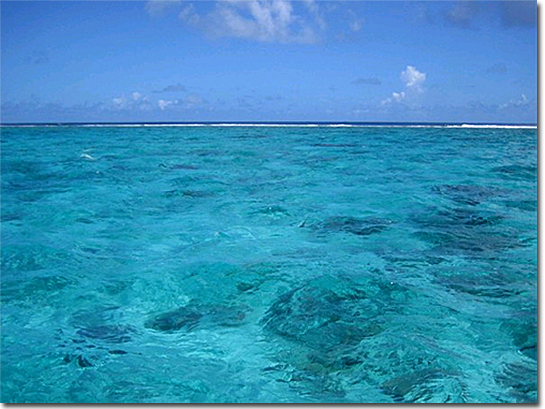
Coral Heads Throughout Tanapag Lagoon.
Image selected by Wendy Savage.
Upon looking at this image I am reminded of one of my favorite photographic artists, Hiroshi Sugimoto. Much like Sugimoto’s “Seascapes”, this image is reminiscent of this series largely because of how the sky meets the sea creating a vast and expansive scene. Although Tanapag Lagoon is more clearly defined by greater variances in both the water and sky, the contrast that defines each area is subtle yet has varied and interspersed details that blend beautifully together. For instance, in the lower two thirds of the image, the blue sky with its pillowing clouds contrast the waving movement of the aqua sea below it. Tanapag Lagoon has a liveliness about it that is apparent throughout creating a lively asymmetry within this rhythmic pattern. The waves illustrated in the foreground facilitate a swirling movement so that the eyes of the viewer move in and out of the photograph further emphasizing the unbounded tempo of the sea.
This image has an open feeling. Variations lie in the subtle shifts of the quality of light that fall upon different areas of the water. In addition, this image makes a statement about impermanence. The ever-changing form of the water is like a cadence in a musical passage that is born, comes to life and then fades away. There are sections that drift in and out, always changing, never the same twice within a passage where the beginning is a blending with its end. The viewer can never make a distinction between the transitioning of the two. Even though this water clearly has an element of permanence it is ephemeral in nature and always in flux. This quality is so clearly apparent within this image.
Although this photograph is minimalist in nature, it is not flat or abstract. It has a depth that is often difficult to express but is clearly understood among people worldwide. When looking at this image, we know it is the water and the sky yet it is devoid of any mark of human presence. There are no ships, jetties or lighthouses inserting themselves as objects of interest or focus.
Lastly, landscapes have changed over millions of years largely because of how man has molded them. In contrast, a seascape must be the least changed scene and the oldest vision that we can share with our ancestors. This rich view of Tanapag Lagoon is what I would describe as a moving meditation. It is present and peaceful yet always in motion to anyone who views it. This is a view humanity shares in differing and detailed ways; it is in the past, the present and the future merged into one. Here is a view I personally find extremely beautiful and comforting.
You can view the original post here: http://www.uri.edu/artsci/his/mua/project_journals/saipan/saipan_4-20-21.shtml
Page source: Underwater Archaeology Invasion Beaches Survey 2008 by Jason Burns and Michael Krivor
Previous Next






